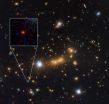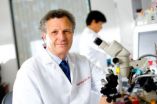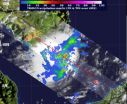(Press-News.org) By combining the power of the NASA/ESA Hubble Space Telescope, NASA's Spitzer Space Telescope and one of nature's zoom lenses, astronomers have found what is probably the most distant galaxy yet seen in the Universe. The object offers a peek back into a time when the Universe was only 3 percent of its present age of 13.7 billion years.
We see the newly discovered galaxy, named MACS0647-JD, as it was 420 million years after the Big Bang. Its light has travelled for 13.3 billion years to reach Earth, which corresponds to a redshift of approximately 11 [1].
This is the latest discovery from the Cluster Lensing And Supernova survey with Hubble (CLASH) [2], which uses massive galaxy clusters as cosmic telescopes to magnify distant galaxies behind them, an effect called gravitational lensing.
"While one occasionally expects to find an extremely distant galaxy using the tremendous power of gravitational lensing, this latest discovery has outstripped even my expectations of what would be possible with the CLASH program," said Rychard Bouwens (Leiden University, Netherlands), a co-author of the study. "The science output in this regard has been incredible."
Along the way, 8 billion years into its journey, the galaxy's light took a detour along multiple paths around the massive galaxy cluster MACS J0647.7+7015. Due to the gravitational lensing, the team observed three magnified images of MACS0647-JD with Hubble. The cluster's gravity boosted the light from the faraway galaxy, making the images appear far brighter than they otherwise would, although they still appear as tiny dots in Hubble's portrait.
"This cluster does what no manmade telescope can do," said Marc Postman (Space Telescope Science Institute, USA), leader of the CLASH team. "Without the magnification, it would require a Herculean effort to observe this galaxy."
The object is so small it may be in the first stages of galaxy formation, with analysis showing the galaxy is less than 600 light-years across. For comparison the Milky Way is 150 000 light-years across. The estimated mass of this baby galaxy is roughly equal to 100 million or a billion suns, or 0.1 - 1 percent the mass of our Milky Way's stars.
"This object may be one of many building blocks of a galaxy," explained Dan Coe (Space Telescope Science Institute), lead author of the study. "Over the next 13 billion years, it may have dozens, hundreds, or even thousands of merging events with other galaxies and galaxy fragments."
The team spent months systematically ruling out all other alternative explanations for the object's identity before concluding that it is the distance record holder. This was important, as nearby objects (such as red stars, brown dwarfs and old or dusty galaxies) can mimic the appearance of an extremely distant galaxy and must be carefully excluded.
The area around the galaxy was observed by Hubble through 17 filters -- spanning near-ultraviolet to near-infrared wavelengths -- with the galaxy appearing only in the two reddest filters. This was consistent with a highly redshifted galaxy, but did not fully exclude other possibilities. Images of the galaxy at longer infrared wavelengths taken by Spitzer were more conclusive, however: if the object were intrinsically red, it would appear bright in these images. Instead, the galaxy was barely detected, if at all.
MACS0647-JD may be too far away for any current telescope to confirm the distance with spectroscopy [3]. Nevertheless, all the evidence points towards the fledgling galaxy being the new distance record holder.
The galaxy will almost certainly be a prime target for the James Webb Space Telescope, scheduled for launch in 2018, which will be able to conduct spectroscopy to make a definitive measurement of its distance and study its properties in more detail.
INFORMATION:
Notes
[1] Redshift is a consequence of the expansion of space over cosmic time, which stretches the wavelength of light. This has the consequence of making a distant object appear redder than it really is. Objects with a higher redshift have had their light stretched more, and are more distant. The previous candidate for the most distant object observed has a redshift of 10.3 ([heic1103][1]); confirmations of several objects with redshifts between 7 and 9 have been reported using spectroscopy, which gives more robust results (see for example [eso1041][2]). This newly discovered galaxy's redshift has been calculated as being approximately 10.8, with a 95% confidence that it lies between 10.3 and 11.3.
[2] The new distance champion is the second remote galaxy uncovered in the CLASH survey, a multiwavelength census of 25 hefty galaxy clusters with Hubble's Advanced Camera for Surveys (ACS) and Wide Field Camera 3 (WFC3) instruments. Earlier this year, the CLASH team announced the discovery of a galaxy that existed when the universe was about 490 million years old (redshift 9.6), 70 million years later than the new record-breaking galaxy. So far, the survey has completed observations for 20 of the 25 clusters.
[3] Redshift can only be precisely measured using spectroscopy, in which an object's light is dispersed and its colour probed in detail. However, it can be estimated by comparing images made of an object through different coloured filters, a method called photometric redshift. The galaxy will only be visible in some of the filters (having been redshifted out of some filters altogether), and the redshift is derived from the bluest filter in which the galaxy is visible. Photometric redshifts, as used in this study, provide less certainty, but they can be calculated for objects much fainter than is possible with spectroscopic redshifts. For this reason, the paper refers to the object as a 'candidate z≈11 galaxy'
[1]: http://www.spacetelescope.org/news/heic1103
[2]: http://www.eso.org/public/news/eso1041
More information
The Hubble Space Telescope is a project of international cooperation between ESA and NASA.
The international team of astronomers in this study consists of:
Dan Coe (Space Telescope Science Institute, Baltimore, USA), Adi Zitrin (Institut fur Theoretische Astrophysik, Heidelberg, Germany), Mauricio Carrasco (Institut fur Theoretische Astrophysik, Heidelberg, Germany and Pontifica Universidad Catolica de Chile, Santiago, Chile), Xinwen Shu (University of Science and Technology of China, Hefei, China), Wei Zheng (Johns Hopkins University, Baltimore, USA), Marc Postman (Space Telescope Science Institute, Baltimore, USA), Larry Bradley (Space Telescope Science Institute, Baltimore, USA), Anton Koekemoer (Space Telescope Science Institute, Baltimore, USA), Rychard Bouwens (Leiden University, Netherlands), Tom Broadhurst (University of the Basque Country, Bilbao, Spain and Ikerbasque Basque Foundation for Science, Bilbao, Spain) Anna Monna (Universitatssternwarter Munchen, Munich, Germany), Ole Host (University College London, London, UK and Dark Cosmology Centre, Niels Bohr Institute, University of Copenhagen, Denmark), Leonidas A. Moustakas (Jet Propulsion Laboratory, California Institute of Technology, La Cañada Flintridge, USA), Holland Ford (Johns Hopkins University, Baltimore, USA), John Moustakas (Siena College, Loudonville, USA), Arjen van der Wel (Max Planck Institute for AStronomy, Heidelberg, Germany), Megan Donahue (Michigan State University, East Lansing, USA), Steven A. Rodney (Johns Hopkins University, Baltimore, USA), Narciso Bentez (Instituto de Astrofisica de Andalucia, Granada, Spain), Stephanie Jouvel (University College London, London, UK and Institut de Cincies de l'Espai, Bellaterra (Barcelona), Spain), Stella Seitz (Universitatssternwarte Munchen, Munich, Germany and Max Planck Institute for Extraterrestrial Physics, Garching, Germany), Daniel D. Kelson (Carnegie Observatories, Pasadena, USA), and Piero Rosati (European Southern Observatory, Garching, Germany)
The research is presented in a paper entitled "CLASH: Three Strongly Lensed Images of a Candidate z≈11 Galaxy" to be published in the December 20 issue of the Astrophysical Journal.
Links
[Images of Hubble]
[NASA press release]
[CLASH collaboration]
[Research paper]
Contacts
Rychard Bouwens
Leiden University
Leiden, Netherlands
Tel: +31 71 527 8456
Email: bouwens@strw.leidenuniv.nl
Dan Coe
Space Telescope Science Institute
Baltimore, USA
Tel: +1 410 338 4312
Email: dcoe@stsci.edu
Oli Usher
Hubble/ESA
Garching, Munich
Tel: +49-89-3200-6855
Email: ousher@eso.org
Hubble helps find candidate for most distant object in the universe yet observed
2012-11-16
ELSE PRESS RELEASES FROM THIS DATE:
Quick, high-volume test offers fast track in search for Alzheimer's drugs
2012-11-16
An efficient, high-volume technique for testing potential drug treatments for Alzheimer's disease uncovered an organic compound that restored motor function and longevity to fruit flies with the disease, according to new research that could help put the search for an effective Alzheimer's drug on a faster track.
Princeton University researchers report in the Journal of Biological Chemistry that they discovered an organic compound that prevented the formation of protein clumps, or aggregates, found on human brain cells afflicted by Alzheimer's disease. The researchers ...
Neurons made from stem cells drive brain activity after transplantation in laboratory model
2012-11-16
LA JOLLA, Calif., November 15, 2012 – Researchers and patients look forward to the day when stem cells might be used to replace dying brain cells in Alzheimer's disease and other neurodegenerative conditions. Scientists are currently able to make neurons and other brain cells from stem cells, but getting these neurons to properly function when transplanted to the host has proven to be more difficult. Now, researchers at Sanford-Burnham Medical Research Institute (Sanford-Burnham) have found a way to stimulate stem cell-derived neurons to direct cognitive function after ...
Barrow scientists discover ways to optimize light sources for vision
2012-11-16
(Phoenix, AZ Nov. 15, 2012) -- Vision researchers at Barrow Neurological Institute have made a groundbreaking discovery into the optimization of light sources to human vision. By tuning lighting devices to work more efficiently with the human brain the researchers believe billions of dollars in energy costs could be saved.
The research was conducted by Stephen Macknik, PhD, of Barrow's Laboratory of Behavioral Neurophysiology, and Susana Martinez-Conde, PhD, of Barrow's Laboratory of Visual Neuroscience. The study is published Proceedings of the National Academy ...
Researchers outline effective strategies to prevent teen depression and suicide
2012-11-16
Untreated depression is one of the leading causes of teen suicide, and signs of depression can also be a warning that a teen is contemplating suicide. In an article published this week in the quarterly journal, The Prevention Researcher, University of Cincinnati researchers are describing how positive connections can help offset these tragedies.
In the current issue, titled, "Teen Depression," UC researchers Keith King, a professor of health promotion, and Rebecca Vidourek, an assistant professor of health promotion, report that depression and suicide are "intricately ...
New injectable gels toughen up after entering the body
2012-11-16
CAMBRIDGE, MA -- Gels that can be injected into the body, carrying drugs or cells that regenerate damaged tissue, hold promise for treating many types of disease, including cancer. However, these injectable gels don't always maintain their solid structure once inside the body.
MIT chemical engineers have now designed an injectable gel that responds to the body's high temperature by forming a reinforcing network that makes the gel much more durable, allowing it to function over a longer period of time.
The research team, led by Bradley Olsen, an assistant professor of ...
Arginine and proline enriched diet may speed wound healing in diabetes
2012-11-16
BETHESDA, Md. (Nov. 15, 2012)—Chronic wounds such as foot ulcers are a common problem for diabetics and are the cause of more than 80 percent of the lower leg amputations in these patients. There is currently no effective way to improve healing of these types of wounds, but new research offers hope.
French researchers found that diabetic rats on a high protein diet with arginine and proline—specific molecules found in protein—showed better wound healing over rats fed either standard or high protein food without arginine and proline supplementation.
The article is entitled ...
Scientists improve dating of early human settlement
2012-11-16
A Simon Fraser University archaeologist and his colleagues at the University of Queensland in Australia have significantly narrowed down the time frame during which the last major chapter in human colonization, the Polynesian triangle, occurred.
SFU professor David Burley, Marshall Weisler and Jian-Xin Zhao argue the first boats arrived between 880 and 896 BC. The 16-year window is far smaller than the previous radiocarbon-dated estimate of 178 years between 2,789 and 2,947 years ago.
Burley, the lead author, and his colleagues have recently had their claims published ...
NASA catches small area of heavy rain in fading Tropical Depression 25W
2012-11-16
Tropical Depression 25W was raining on southern Vietnam on Nov. 14 when NASA's TRMM satellite passed overhead and measured rainfall rates within the storm. TRMM noticed that the heaviest rainfall was limited to a small area and was located over open waters.
NASA's TRMM or Tropical Rainfall Measuring Mission satellite was launched in 1997, and can read that rate at which rain falls in storms on Earth from its orbit in space. NASA's TRMM satellite flew over Tropical Depression 25W on Nov. 14 at 0133 UTC and captured rainfall rate data. The TRMM data showed a small area ...
Most-distant galaxy candidate found
2012-11-16
Pasadena, CA— A team of astronomers including Carnegie's Daniel Kelson have set a new distance record for finding the farthest galaxy yet seen in the universe. By combining the power of NASA's Hubble Space Telescope, Spitzer Space Telescope, and one of nature's own natural "zoom lenses" in space, they found a galaxy whose light traveled 13.3 billion years to reach Earth. Their work will be published in The Astrophysical Journal.
The diminutive blob--only a tiny fraction of the size of our Milky Way galaxy--offers a peek back in time to when the universe was 3 percent ...
Hinode views 2 solar eclipses
2012-11-16
VIDEO:
The JAXA/NASA Hinode mission witnessed two solar eclipses on Nov. 13, 2012, near in time to when a solar eclipse was visible in the southern hemisphere. This movie shows the...
Click here for more information.
Observers in Australia and the South Pacific were treated to a total solar eclipse on Nov. 13, 2012. The orbit of Hinode resulted in two eclipses this time, each with a somewhat different perspective. The first eclipse was total. During the second, the moon skimmed ...



